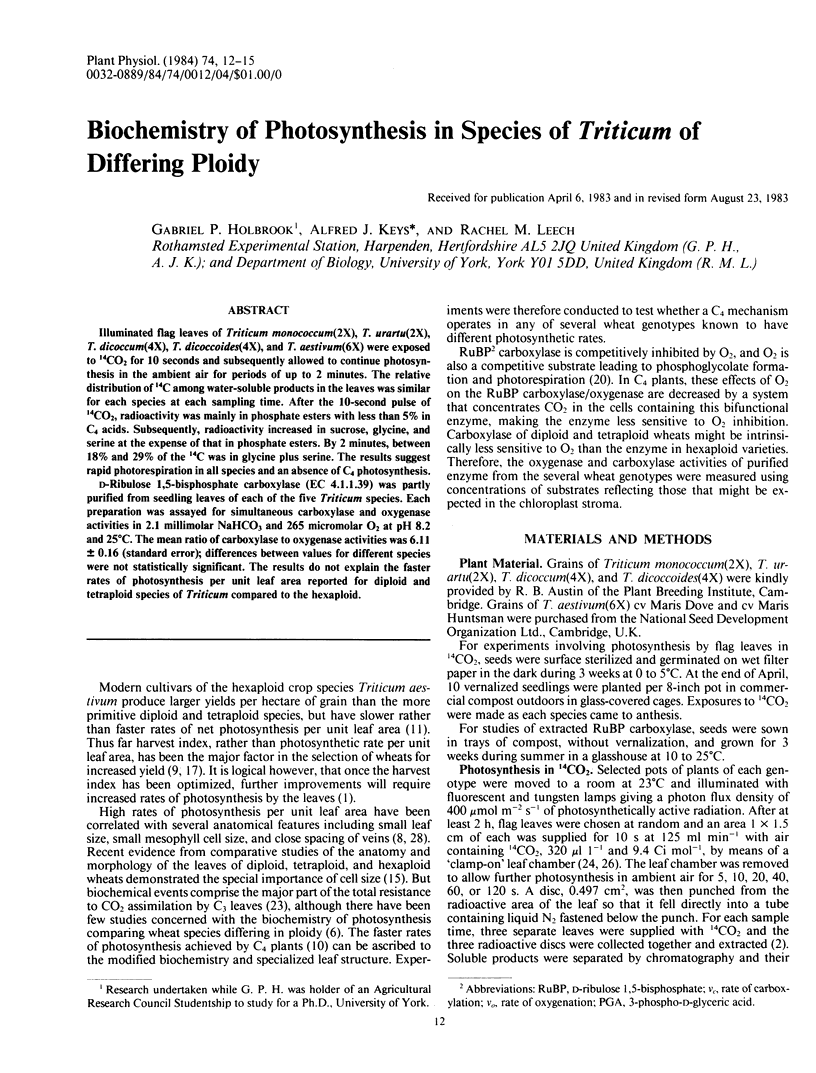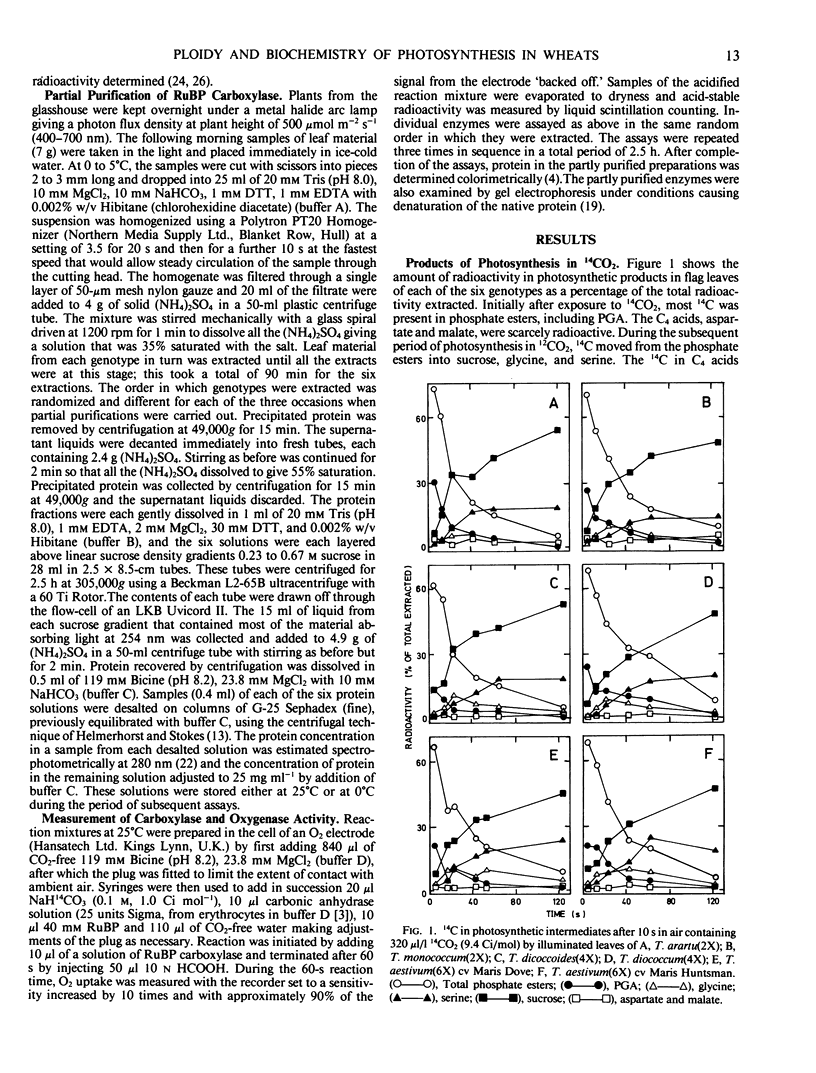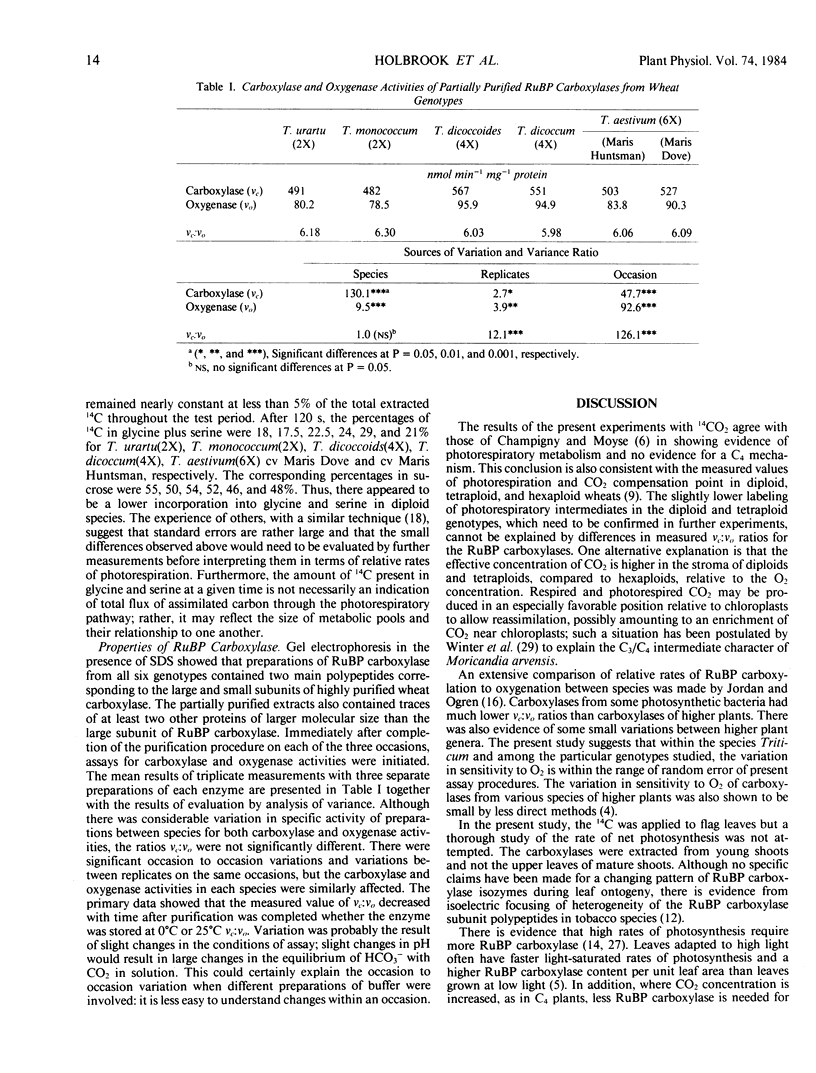Abstract
Illuminated flag leaves of Triticum monococcum(2X), T. urartu(2X), T. dicoccum(4X), T. dicoccoides(4X), and T. aestivum(6X) were exposed to 14CO2 for 10 seconds and subsequently allowed to continue photosynthesis in the ambient air for periods of up to 2 minutes. The relative distribution of 14C among water-soluble products in the leaves was similar for each species at each sampling time. After the 10-second pulse of 14CO2, radioactivity was mainly in phosphate esters with less than 5% in C4 acids. Subsequently, radioactivity increased in sucrose, glycine, and serine at the expense of that in phosphate esters. By 2 minutes, between 18% and 29% of the 14C was in glycine plus serine. The results suggest rapid photorespiration in all species and an absence of C4 photosynthesis.
d-Ribulose 1,5-bisphosphate carboxylase (EC 4.1.1.39) was partly purified from seedling leaves of each of the five Triticum species. Each preparation was assayed for simultaneous carboxylase and oxygenase activities in 2.1 millimolar NaHCO3 and 265 micromolar O2 at pH 8.2 and 25°C. The mean ratio of carboxylase to oxygenase activities was 6.11 ± 0.16 (standard error); differences between values for different species were not statistically significant. The results do not explain the faster rates of photosynthesis per unit leaf area reported for diploid and tetraploid species of Triticum compared to the hexaploid.
Full text
PDF



Selected References
These references are in PubMed. This may not be the complete list of references from this article.
- BIELESKI R. L. THE PROBLEM OF HALTING ENZYME ACTION WHEN EXTRACTING PLANT TISSUES. Anal Biochem. 1964 Dec;9:431–442. doi: 10.1016/0003-2697(64)90204-0. [DOI] [PubMed] [Google Scholar]
- Dean C., Leech R. M. Genome Expression during Normal Leaf Development : 2. Direct Correlation between Ribulose Bisphosphate Carboxylase Content and Nuclear Ploidy in a Polyploid Series of Wheat. Plant Physiol. 1982 Dec;70(6):1605–1608. doi: 10.1104/pp.70.6.1605. [DOI] [PMC free article] [PubMed] [Google Scholar]
- Gray J. C., Kung S. D., Wildman S. G. Polypeptide chains of the large and small subunits of fraction I protein from tobacco. Arch Biochem Biophys. 1978 Jan 15;185(1):272–281. doi: 10.1016/0003-9861(78)90167-4. [DOI] [PubMed] [Google Scholar]
- Helmerhorst E., Stokes G. B. Microcentrifuge desalting: a rapid, quantitative method for desalting small amounts of protein. Anal Biochem. 1980 May 1;104(1):130–135. doi: 10.1016/0003-2697(80)90287-0. [DOI] [PubMed] [Google Scholar]
- Laemmli U. K. Cleavage of structural proteins during the assembly of the head of bacteriophage T4. Nature. 1970 Aug 15;227(5259):680–685. doi: 10.1038/227680a0. [DOI] [PubMed] [Google Scholar]
- Laing W. A. Regulation of Soybean Net Photosynthetic CO(2) Fixation by the Interaction of CO(2), O(2), and Ribulose 1,5-Diphosphate Carboxylase. Plant Physiol. 1974 Nov;54(5):678–685. doi: 10.1104/pp.54.5.678. [DOI] [PMC free article] [PubMed] [Google Scholar]
- Paulsen J. M., Lane M. D. Spinach ribulose diphosphate carboxylase. I. Purification and properties of the enzyme. Biochemistry. 1966 Jul;5(7):2350–2357. doi: 10.1021/bi00871a025. [DOI] [PubMed] [Google Scholar]
- Winter K., Usuda H., Tsuzuki M., Schmitt M., Edwards G. E., Thomas R. J., Evert R. F. Influence of Nitrate and Ammonia on Photosynthetic Characteristics and Leaf Anatomy of Moricandia arvensis. Plant Physiol. 1982 Aug;70(2):616–625. doi: 10.1104/pp.70.2.616. [DOI] [PMC free article] [PubMed] [Google Scholar]


